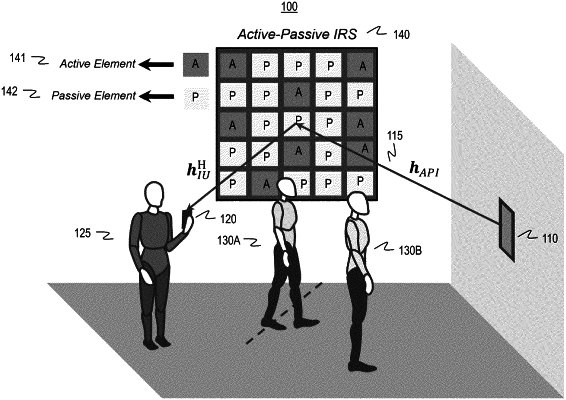| CPC H04B 7/04013 (2023.05) [H04B 7/145 (2013.01); H04B 7/15 (2013.01)] | 20 Claims |

|
1. In a communication system including a transmitter configured to transmit a wireless signal, a receiver, and an Intelligent Reflective Surface (IRS) that receives the wireless signal from the transmitter and provides the wireless signal to the receiver, the IRS including a plurality of elements whose function is switchable from operating as a passive element that is operable to reflect the wireless signal without amplifying the wireless signal, to operating as an active element that is able to provide amplification to the wireless signal when power is supplied to the active element, a method comprising:
receiving a plurality of inputs, the plurality of inputs at least (1) specifying a total power amount for the communication system, the total power amount being the amount of power available to power the transmitter and the plurality of elements of the IRS, (2) specifying one or more communication system operational parameters, and (3) specifying a number of elements implemented in the IRS;
based on the plurality of inputs, calculating for a first element implemented in the IRS a first portion of the total power amount needed to switch the first element from operating as a passive element to operating as an active element, an amplification amount for the first element, and a signal-to-noise ratio (SNR) of the wireless signal received at the receiver when the first element is an active element;
based on the inputs, calculating for a combination of the first element and a second element implemented in the IRS, a second portion of the total power amount needed to switch the first and second elements from operating as passive elements to operating as active elements, an amplification amount for the first and second elements, and an SNR of the wireless signal received at the receiver when the first and second elements are operating as active elements;
based on the input, repeating for all combinations of the plurality of elements implemented in the IRS the calculation of the portion of total power needed to switch the combination of elements from operating as passive elements to operating as active elements, the calculation of the amplification amount for the combination of elements, and the calculation of an SNR of the wireless signal received at the receiver when all combinations of the plurality of elements are operating as active elements; and
based on the calculations, selecting a number of elements of the IRS implemented in the IRS to switch from operating as passive elements to operating as active elements that will result in a maximum SNR of the wireless signal received at the receiver.
|